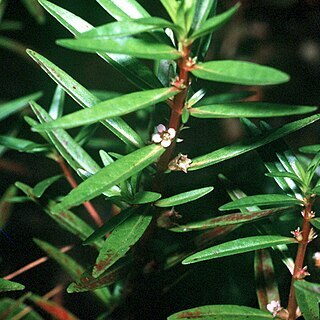Erect palustrine herbs to 3.5 dm. tall; branches somewhat angular at least toward the apex. Leaves elliptic or elliptic-oblanceolate, obtuse at the apex, cuneate to attenuate-cuneate at the base, 0.7-3.7 cm. long, 0.1-0.8 cm. wide. Flowers sessile, subtended by 2 linear bracts to 5 mm. long, 0.75 mm. wide. Hypanthium urceolate, 2.75-3.0 mm. long, 1.5-2.0 mm. broad at the orifice; calyx lobes broadly deltoid. Petals 0.7-1.25 mm. long, 0.6-0.75 mm. wide, white. Stamens as many as calyx lobes, minute, the anthers ovoid, about 0.3 mm. long, 0.3 mm. wide, the filaments to 1 mm. long. Ovary globose, 1.5-2.0 mm. long, sessile; style 0.2-0.5 mm. long. Seeds orbicular, about 0.25 mm. in diameter.
Erect or prostrate, 1–4 dm, often freely branched; lvs opposite or whorled, linear-spatulate, 1–3(–5) cm, mostly obtuse; sep alternating with triangular appendages of nearly the same size; pet white or pink, minute, caducous; fr 3–5 mm; 2n=32. In mud or wet soil; near the coast from Mass. to Fla. and Tex.; inland from O. and Mich. to Minn., Ark., and Okla.; also on the Pacific coast, in Mexico, and trop. Amer.


